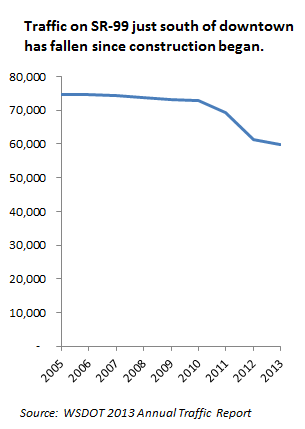Oy. A few weeks back I wrote about new data from the Seattle Department of Transportation showing that traffic on the Alaskan Way Viaduct had plummeted. But now, SDOT is backing away from their numbers:
In 2012, due to the ongoing construction of the South Atlantic Street overpass, we were not able to collect valid data for the SR 99 on- and off-ramps located near the stadiums. As a result, SDOT was not able to calculate our own number for 2012 volumes on the Alaskan Way Viaduct.
Instead, a volume from a Washington State Department of Transportation (WSDOT) counter on SR 99 south of the stadium ramps was used…These changes in the data should have been noted on the 2012 Traffic Flow Map, but were not.
This means that our chart, which showed a collapse in traffic volumes on the Viaduct, was based on data that SDOT no longer supports—which suggests that it could well be wrong.
However, that’s not the end of the story. WSDOT just released its 2013 Annual Traffic Report, with a consistent time series for SR-99 just north of the West Seattle Bridge. And that time series still shows a sizable drop in SR-99 traffic:
Still, actual Viaduct traffic through downtown Seattle remains something of a mystery. SDOT simply doesn’t know how many cars are using the Viaduct—and if SDOT doesn’t know, nobody does.
Still, given the trends just south of downtown, it’s almost certain that traffic on the Viaduct has experienced a notable dip since the state started construction…which raises at least some hope that even if the engineers never get Bertha started again, the city could gradually adapt to life without a highway along the waterfront.










mic
So WSDOT and SDOT can’t count?
Shocking news, just shocking!
RST
Publicola has a related story:
http://www.seattlemet.com/news-and-profiles/publicola/articles/fizz-for-march-27unjustified-march-2014
There’s some 1995 PSRC projections there, for Seattle household and job growth. The household growth is about right, and it turns out the jobs estimates were considerably too rosy. Interestingly, those projections were that high income and high-mid income household growth (on a % basis) would be considerably greater than low income job growth between 1995 and 2020. That seems counterintuitive. What is the reality on that score?
Robert
In other words, all your articles about how traffic in Seattle has collapsed were just a complete load of garbage and should be utterly ignored, as any intelligent person had done, anyway.
You do realize that SR99 has had a reduction in the number of traffic lanes since that construction started, right? So, the capacity of SR99 where the counts were made is far lower than it was before construction began.
When you eliminate traffic lanes from heavily-used highways, capacity falls, and traffic volumes fall, by necessity. IS this some sort of revelation to you?
The Alaskan Way viaduct is at or over capacity every day during peak hours. It’s just that the capacity of the viaduct, and SR99 north and south of the viaduct, has been reduced by at least one lane in each direction. So, obviously, traffic volumes have been FORCED lower.
Clark Williams-Derry
Hm. You seem to say that traffic hasn’t fallen (ie., that everything that I wrote is garbage) and then go on to explain why traffic has fallen.
I think what’s going on is that we actually agree: construction on the Viaduct has reduced traffic throughput. You seem to be angry with me about this. I’m not sure why.
Robert
Traffic has not fallen nearly as much as you had been writing before this current column. Your earlier figures were garbage, as this column points out.
Also, your implication has been that traffic has fallen because people want to drive less. There is nothing in the accurate figures to suggest this. It is very clear that traffic has fallen because capacity has fallen — not because people want to drive less.
Also, you have been trying to use those garbage, false figures for viaduct traffic to “prove” that we don’t need to replace the viaduct with another highway. That is patently absurd. We should be replacing the viaduct with another highway with capacity equal or greater to the viaduct in its original configuration, to relieve the terrible traffic congestion currently on SR99 through Seattle during peak hours.
Clark Williams-Derry
Hm. I do not think I ever said or implied that traffic on the Viaduct has fallen because people “want” to drive less. I think you’re imposing your own interpretation on what I’ve written.
Ann Dasch
Don’t blame Sightline – they just reported the data available. But the point remains: Drivers change our behavior, adapting to external conditions. If the state doesn’t build a tunnel, we will adapt. If the toll is too high, we won’t use that road.